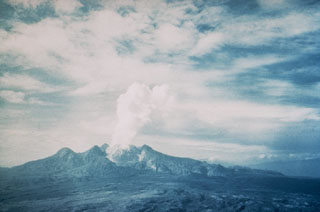Report on Lamington (Papua New Guinea) — September 2003
Bulletin of the Global Volcanism Network, vol. 28, no. 9 (September 2003)
Managing Editor: Edward Venzke.
Lamington (Papua New Guinea) High-frequency earthquakes began in early July
Please cite this report as:
Global Volcanism Program, 2003. Report on Lamington (Papua New Guinea) (Venzke, E., ed.). Bulletin of the Global Volcanism Network, 28:9. Smithsonian Institution. https://doi.org/10.5479/si.GVP.BGVN200309-253010
Lamington
Papua New Guinea
8.95°S, 148.15°E; summit elev. 1680 m
All times are local (unless otherwise noted)
The Rabaul Volcanological Observatory reported that Lamington remained quiet over the period 25 June-9 October 2003. Vapor emissions were difficult to observe because of the distance to the observation point, but on a few clear days very small volumes of thin white vapor were seen in the summit area. The report also noted that high-frequency volcano-tectonic-like earthquakes began in early July at a rate of up to five events per day and continued into early October. This is the first time since the seismic station was re-established in 1997 that these types of earthquakes have been recorded in significant numbers over a short period of time.
Geological Summary. Lamington is an andesitic stratovolcano with a 1.3-km-wide breached summit crater containing a lava dome that rises above the coastal plain of the Papuan Peninsula of New Guinea north of the Owen Stanley Range. A summit complex of lava domes and crater remnants tops a low-angle base of volcaniclastic deposits dissected by radial valleys. A prominent broad "avalanche valley" extends northward from the breached crater. Ash layers from two early Holocene eruptions have been identified. In 1951 a powerful explosive eruption produced pyroclastic flows and surges that swept all sides of the volcano, killing nearly 3,000 people. The eruption concluded with growth of a 560-m-high lava dome in the summit crater.
Information Contacts: Ima Itikarai, Rabaul Volcanological Observatory, P.O. Box 386, Rabaul, Papua New Guinea.

